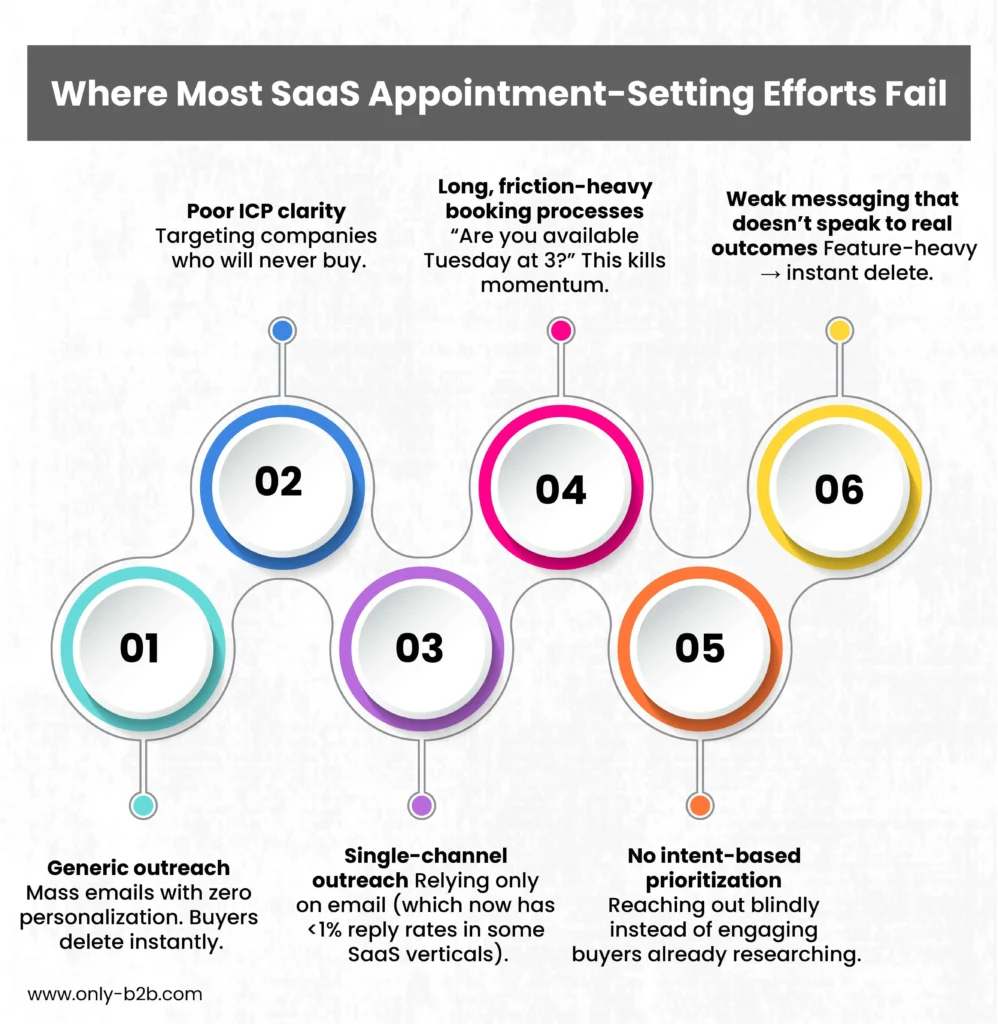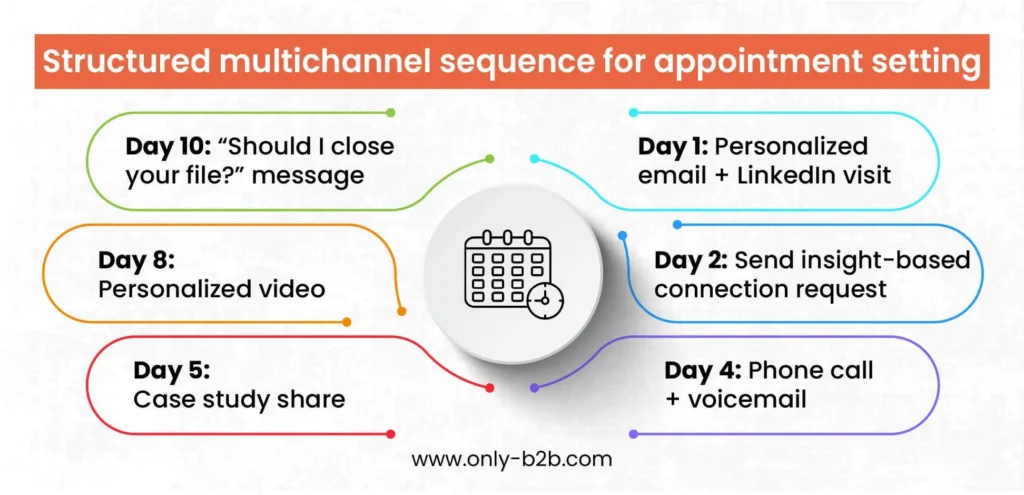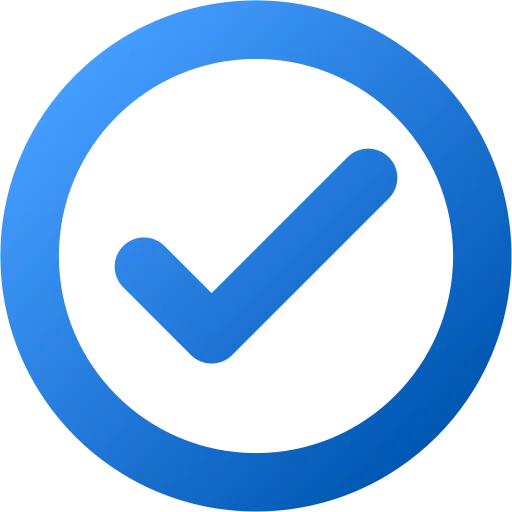Not long ago, we met a SaaS founder of a fast-growing startup who had reached a frustrating point.
On paper, everything looked fine. The product was solid, word of mouth was strong, and the company had already crossed $1M+ in ARR. The best part was that when prospects got on a call, more than 50 percent converted into paying customers.
Then what was the frustration about?
“If we get a meeting, we usually win. But getting the meeting is the real challenge. Competition is intense, and were are booking only 5 to 6 meetings per month and closing 2 to 3 of them.”
It was not a product issue or a sales script issue. The problem clearly existed at the top of the funnel. Hiring and managing an SDR team from scratch felt risky and expensive, especially when it was not the founder’s core strength.
That is when they decided to outsource an appointment setting to increase their meeting volume. This situation is not unique. It is the story of many B2B SaaS businesses.
This blog explores exactly how founders can move from “we close when we get the meeting” to “we consistently get in front of the right buyers at scale.”
Why Appointment Setting Matters More Than Ever in SaaS
Table of Contents
- 1 Why Appointment Setting Matters More Than Ever in SaaS
- 2 The Real Problem: SaaS Buyers Are Not Hard to Sell. They Are Hard to Access
- 3 What Actually Works in SaaS Appointment Setting
- 3.1 1. Start With a Hyper-Specific ICP (Not a Broad One)
- 3.2 2. Use Intent Data to Prioritize In-Market Buyers
- 3.3 3. Build Multi-Channel Sequences (The New Standard)
- 3.4 4. Personalize Every Message Not Just the First Line
- 3.5 5. Use Value-First Messaging (Not Feature Pitches)
- 3.6 6. Use Social Proof Early
- 3.7 7. Create a Frictionless Booking Experience
- 3.8 8. Build Alignment Between Founder, SDR, and Marketing
- 3.9 9. Track the Metrics That Actually Matter
- 3.10 10. Blend Automation and Human Touch
- 4 Predictable SaaS Growth Starts at the Top of the Funnel
Without a strong pipeline, your meeting conversion rate looks good only because the pipeline itself is weak. Today’s SaaS buyers are overwhelmed, distracted, and selective. According to Gartner:
- Only 17 percent of the buying journey is spent with vendors.
- A typical B2B buying group includes 6 to 10 stakeholders, each consuming 4 to 6 pieces of content before agreeing to a meeting.
- Eighty-three percent of buyers prefer doing independent research before speaking to sales.
This makes it essential to excel in two key areas:
- Reach buyers earlier, before your competitors do.
- Prove relevance instantly, without a hard pitch.
To do this effectively, you must incorporate personalization, insight, and timing into everything you execute.

The Real Problem: SaaS Buyers Are Not Hard to Sell. They Are Hard to Access
If you ask a SaaS founder what the biggest challenge is in converting appointments into sales, the likely response will be:
“Our product is strong, our conversion rate is high, but getting attention is the biggest roadblock”.
This bottleneck is extremely difficult to crack because appointment setting is affected by several structural SaaS challenges.
1. Competitive saturation
Every category, such as RevOps, martech, product analytics, cybersecurity, and DevOps tools, has 20 to 50 players competing. To stand out, you must be precise with your content and outreach. High volume works against you.
2. Buyers are risk-averse
Forrester reports that 68 percent of buyers delay meetings until they have completed enough internal research. They want to avoid being sold too early.
3. Internal consensus slows everything
Buying cycles have become 60 percent longer due to multi-stakeholder involvement, according to McKinsey.
These factors show that buyers are harder to reach, slower to respond, and significantly more selective.
This leads to the real question. How do you earn a meeting in this kind of environment?
What Actually Works in SaaS Appointment Setting
Buyer behavior is shifting fast, yet many sales processes remain outdated.
So what is the ideal approach?
It should be quietly helpful, not aggressively sales-focused.
Use intent signals to target in-market accounts, personalize around real problems, lead with insight instead of a demo request, show proof early, and make scheduling a short, low-pressure meeting as simple as one click.
When done correctly, top-of-funnel issues disappear, and your pipeline becomes healthy enough to grow consistently.
Here is your step-by-step playbook to improve appointment setting in B2B SaaS.
1. Start With a Hyper-Specific ICP (Not a Broad One)
“Mid-market companies in the U.S. with 50 to 200 employees.”
If this resembles your current ICP, you are still casting too wide a net and catching very little.
High-performing SaaS companies define ICPs with micro specificity:
- Company maturity stage, such as Seed, Series B, or Enterprise
- Stack indicators such as Salesforce, HubSpot, Snowflake, or AWS
- Hiring signals such as recent hires in Ops, RevOps, DevOps, or CS
- Pain signals such as support tickets, security incidents, or churn spikes
- Trigger events such as funding, product launches, or acquisitions
The more you narrow and tailor your ICP, the more likely prospects will say yes.
2. Use Intent Data to Prioritize In-Market Buyers
There is a clear difference between people who are simply a good fit and people who are actively looking now.The latter group is instantly rewarding. Many teams know intent signals work, but they do not completely understand how to leverage them. Here are the key signals you should track:
- G2 category visits
- Searches related to your product’s problem
- Competitor comparisons
- Content downloads
- Spikes in keyword consumption on platforms like Bombora or ZoomInfo
Outreach is often random. When you layer intent signals into your process, outreach becomes targeted and significantly more effective.
3. Build Multi-Channel Sequences (The New Standard)
You can no longer rely only on email. Single-channel outreach is not enough to break through. The winning SaaS appointment setting playbook uses five channels:
- Phone with light touches
- Video messages
- Value-driven content nudges
You may have tried some of these individually, but the real impact comes from stitching them into one structured sequence. High-performing teams run 8 to 12 touches across 14 to 21 days. Remember, this works only when you consistently refine and improve your outreach.

4. Personalize Every Message Not Just the First Line
Seventy-one percent of B2B buyers expect personalization on their first interaction. Many understand this but still default to surface-level personalization. Real personalization goes much deeper.
It includes:
- Referencing the buyer’s tech stack
- Highlighting a specific pain point
- Citing a company announcement
- Sharing relevant case studies
- Speaking directly to their KPIs
5. Use Value-First Messaging (Not Feature Pitches)
Buyers do not care about features. Everyone knows this, yet teams often default to feature-based messaging because it feels comfortable.
What SaaS buyers truly care about is achieving more with fewer resources.
They value:
- Efficiency
- Reduced workload
- Revenue impact
- Automation
- Cost savings
- Risk reduction
- Customer experience
Your outreach should always answer:
“Why is this meeting worth my time”
Example CTA:
“Can I show you how SaaS companies like yours reduced onboarding time by 40 percent using a lightweight workflow automation layer”
6. Use Social Proof Early
Prospects trust results from companies similar to theirs. Gartner notes that 77 percent of buyers trust peer recommendations more than vendor statements. This is why early proof consistently outperforms clever messaging.
Use:
✔ Customer logos
✔ ROI proof
✔ G2 badges
✔ Short 45-second case study videos
✔ Snapshot metrics such as “Reduced churn by 22 percent”
When buyers see relatable outcomes, agreeing to a meeting becomes easier.
7. Create a Frictionless Booking Experience
Prospects protect their time, and any scheduling friction slows them down. Your goal is to make the next step as simple as possible.
Use:
✔ Calendar links
✔ One click scheduling
✔ Clear agendas
✔ Short 15 to 20 minute intro calls
✔ Optional zero pitch discovery calls
The easier the process, the more meetings get booked.
8. Build Alignment Between Founder, SDR, and Marketing
Buyers notice when messaging changes across touchpoints. A unified narrative builds trust and makes your offer easier to understand. A 2024 Demand Gen Report shows that aligned teams generate 208 percent more revenue.
Align across:
✔ Website
✔ Emails
✔ Product positioning
✔ Social content
✔ SDR outreach
Consistency strengthens credibility and increases conversions.
9. Track the Metrics That Actually Matter
Improving appointment setting is a data-driven exercise. The right metrics reveal where prospects slow down and where they move forward.
Track:
✔ Contact to meeting rate
✔ Conversation rate
✔ Meeting acceptance rate
✔ No show rate
✔ Pipeline generated per meeting
✔ Time to demo
✔ Win rate from outbound
These metrics help you identify and fix friction quickly.
10. Blend Automation and Human Touch
Automation ensures consistency in your outreach. Human interactions make your messaging relevant and relatable.
Automation handles:
✔ List building
✔ Data enrichment
✔ Sequence execution
✔ Intent monitoring
Humans handle:
✔ Deep personalization
✔ Natural conversations
✔ Objection handling
✔ Resonant messaging
This balance gives buyers what they want: efficiency combined with authenticity.
Predictable SaaS Growth Starts at the Top of the Funnel
SaaS companies do not fail because their product cannot close. They fail because they struggle to start the conversation.
Modern appointment setting is not about volume. It is about:
- Precision
- Buyer intent
- Personalization
- Timing
- Messaging relevance
- Multi channel presence
- Social proof
- Frictionless scheduling
Master these, and reaching 2 million dollars, 5 million dollars, or even 10 million dollars in ARR becomes a process, not luck.

Vikas Bhatt is the Co-Founder of ONLY B2B, a premium B2B lead generation company that specializes in helping businesses achieve their growth objectives through targeted marketing & sales campaigns. With 10+ years of experience in the industry, Vikas has a deep understanding of the challenges faced by businesses today and has developed a unique approach to lead generation that has helped clients across a range of industries around the globe. As a thought leader in the B2B marketing community, ONLY B2B specializes in demand generation, content syndication, database services and more.





